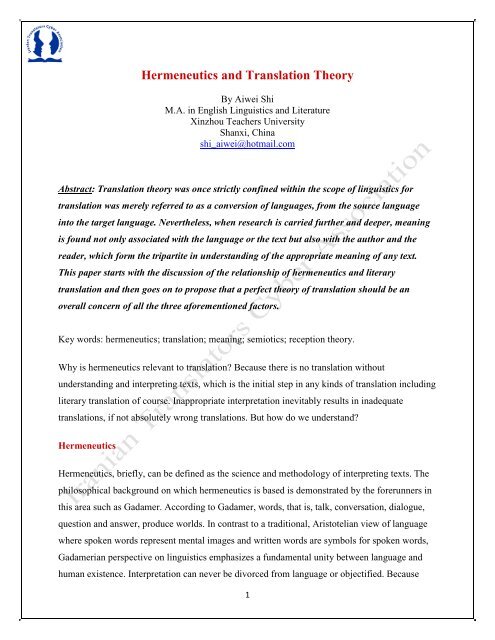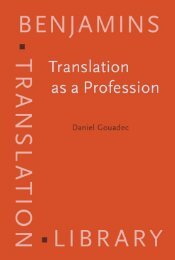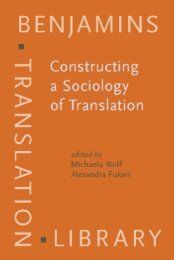Hermeneutics and Translation Theory.pdf
Hermeneutics and Translation Theory.pdf
Hermeneutics and Translation Theory.pdf
You also want an ePaper? Increase the reach of your titles
YUMPU automatically turns print PDFs into web optimized ePapers that Google loves.
<strong>Hermeneutics</strong> <strong>and</strong> <strong>Translation</strong> <strong>Theory</strong>By Aiwei ShiM.A. in English Linguistics <strong>and</strong> LiteratureXinzhou Teachers UniversityShanxi, Chinashi_aiwei@hotmail.comAbstract: <strong>Translation</strong> theory was once strictly confined within the scope of linguistics fortranslation was merely referred to as a conversion of languages, from the source languageinto the target language. Nevertheless, when research is carried further <strong>and</strong> deeper, meaningis found not only associated with the language or the text but also with the author <strong>and</strong> thereader, which form the tripartite in underst<strong>and</strong>ing of the appropriate meaning of any text.This paper starts with the discussion of the relationship of hermeneutics <strong>and</strong> literarytranslation <strong>and</strong> then goes on to propose that a perfect theory of translation should be anoverall concern of all the three aforementioned factors.Key words: hermeneutics; translation; meaning; semiotics; reception theory.Why is hermeneutics relevant to translation? Because there is no translation withoutunderst<strong>and</strong>ing <strong>and</strong> interpreting texts, which is the initial step in any kinds of translation includingliterary translation of course. Inappropriate interpretation inevitably results in inadequatetranslations, if not absolutely wrong translations. But how do we underst<strong>and</strong>?<strong>Hermeneutics</strong><strong>Hermeneutics</strong>, briefly, can be defined as the science <strong>and</strong> methodology of interpreting texts. Thephilosophical background on which hermeneutics is based is demonstrated by the forerunners inthis area such as Gadamer. According to Gadamer, words, that is, talk, conversation, dialogue,question <strong>and</strong> answer, produce worlds. In contrast to a traditional, Aristotelian view of languagewhere spoken words represent mental images <strong>and</strong> written words are symbols for spoken words,Gadamerian perspective on linguistics emphasizes a fundamental unity between language <strong>and</strong>human existence. Interpretation can never be divorced from language or objectified. Because1
Iranian Translators Cyber Association Articleslanguage comes to humans with meaning, interpretations <strong>and</strong> underst<strong>and</strong>ings of the world cannever be prejudice-free. As human beings, one cannot step outside of language <strong>and</strong> look atlanguage or the world from some objective st<strong>and</strong>point. Language is not a tool which humanbeings manipulate to represent a meaning-full world; rather, language forms human reality.(quoted from Bullock, 1997)Another important figure in this sphere is Schleiermacher whose concept of underst<strong>and</strong>ingincludes empathy as well as intuitive linguistic analysis. He believed that underst<strong>and</strong>ing is notmerely the decoding of encoded information, interpretation is built upon underst<strong>and</strong>ing, <strong>and</strong> ithas a grammatical, as well as a psychological moment. The grammatical thrust places the textwithin a particular literature (or language) <strong>and</strong> reciprocally uses the text to redefine the characterof that literature. The psychological thrust is more naive <strong>and</strong> linear. In it, the interpreterreconstructs <strong>and</strong> explicates the subject's motives <strong>and</strong> implicit assumptions. Thus Schleiermacherclaimed that a successful interpreter could underst<strong>and</strong> the author as well, as or even better than,the author understood himself because the interpretation highlights hidden motives <strong>and</strong>strategies. (quoted from the web: www.ai.mit.edu)Dilthey, initially a follower of Schleiermacher, went further. He began to emphasize that texts<strong>and</strong> actions were as much products of their times as expressions of individuals, <strong>and</strong> theirmeanings were consequently constrained by both an orientation to values of their period <strong>and</strong> aplace in the web of their authors' plans <strong>and</strong> experiences. Therefore meanings are delineated bythe author's world-view reflecting a historical period <strong>and</strong> social context. Underst<strong>and</strong>ing(verstehen), the basis for methodological hermeneutics, involves tracing a circle from text to theauthor's biography <strong>and</strong> immediate historical circumstances <strong>and</strong> back again. Interpretation, or thesystematic application of underst<strong>and</strong>ing to the text, reconstructs the world in which the text wasproduced <strong>and</strong> places the text in that world. (ibid)Modern ideas on hermeneutics hold that the writer may be an editor or a redactor <strong>and</strong> that hemay have used sources. In considering this aspect of discourse one must take into account thewriter's purpose in writing as well as his cultural milieu. Secondly, one must consider thenarrator in the writing who is usually different from the writer. Sometimes he is a real person,2
sometimes fictional. One must determine his purpose in speaking <strong>and</strong> his cultural milieu, takinginto consideration the fact that he may be omnipresent <strong>and</strong> omniscient. One must also take intoconsideration the narratee within the story <strong>and</strong> how he hears. But even then one is not finished.One must reckon with the person or persons to whom the writing is addressed; the reader, notalways the same as the one to whom the writing is addressed; <strong>and</strong> later readers. Thirdly, onemust consider the setting of writing, the genre (whether poetry, narrative, prophecy, etc.), thefigures of speech; the devices used, <strong>and</strong>, finally, the plot. (Hanko, 1991)Following the above ideas, we realize that underst<strong>and</strong>ing <strong>and</strong> interpreting the meaning of adiscourse involves actually three factors: the author (writer), the text (or speech) <strong>and</strong> the reader.My Underst<strong>and</strong>ing of <strong>Translation</strong><strong>Translation</strong>, according to Nida (1984) consists in reproducing in the receptor language the closestnatural equivalent of the source language massage, first in terms of meaning <strong>and</strong> secondly interms of style. The Chinese cihai (unabridged dictionary) defines translation as: expressing inanother language the meaning carried in the original language (my translation from Chinese).Here meaning is apparently in the limelight of translation, which is why adequate underst<strong>and</strong>ing<strong>and</strong> interpretation is always an iron criterion in judging whether a piece of translation succeedsor fails. Style is another indispensable factor involved in translation but cannot be treated in thispaper for it is not directly relevant to the present topic.I believe however meaning is never concrete <strong>and</strong> tangible as many may claim <strong>and</strong> translation ofmeaning can only achieve a sort of approximation instead of exactness as is believed by somescholars working in the field. I reckon that when the translated meaning produces the same or asimilar response in the target reader or listener as it does the original reader, the translation issuccessful by my st<strong>and</strong>ard. Newmark (1982) says that it is preferable to h<strong>and</strong>le the issue in termsof equivalence of intended effects, thus linking judgments about what the translator seeks toachieve to judgments about the intended meaning of the ST speaker/writer. In other words I donot seek to reproduce the exactness of the original but always bear in my mind the rule of havingthe same effect on the target reader. This assertion is grounded on the fact that it is believed by3
Iranian Translators Cyber Association Articlesmany that translation is itself an end, serving a certain purpose. When it comes to a differentpoint of view-translation is also a medium, or a process, I have something different to say.Simply put, translation involves decoding of the original discourse <strong>and</strong> encoding of the targetdiscourse, both done by the translator or interpreter. During this process, absolute faithfulness oraccuracy is but an illusion, or best, an impossible idealistic pursuit. To achieve the maximumeffect or impact of the original discourse <strong>and</strong> to avoid failure of communication,accommodations are made for a variety of reasons. (See my paper Accommodations in<strong>Translation</strong> for reference, at www.accurapid.com)In a word, translation in my opinion is both a process <strong>and</strong> a product. Research therefore ought toinclude all factors <strong>and</strong> elements concerned about them both.The Three Factors All ConsideredIn the following discussion I will concentrate on the development of translation theory on thehermeneutic basis.The AuthorCentering on the author, there has been a lot of followers who preach that in literary translation athorough study of the author's life experience, historical <strong>and</strong> social background is of paramountnecessity for any translator to ensure interpretation of the author's meaning or intention is mostadequate. There have been many articles <strong>and</strong> theses on evaluation of a literary work, diggingquite in depth those factors about the author to make sure the interpretation of the work is theclosest. For example, in translating Shakespeare into Chinese many would draw heavily fromhistory. "The 16th century in Engl<strong>and</strong> was a period of the breaking up of feudal relations <strong>and</strong> theestablishing of the foundations of capitalism."(Wu, 1996: p71) "Together with the developmentof bourgeois relationships <strong>and</strong> formation of the English national state this period is marked by aflourishing of national culture known as the Renaissance" which originally indicated "a revivalof classical arts <strong>and</strong> sciences after the dark ages of medieval obscurantism." Shakespeare as ahumanist held his chief interest not in ecclesiastical knowledge, but in man, his environment <strong>and</strong>4
doings <strong>and</strong> "bravely fought for the emancipation of man from the tyranny of the church <strong>and</strong>religious dogmas." (ibid, p72-73) He was a dramatist, poet, actor <strong>and</strong> proprietor <strong>and</strong> he produced37 plays, two narrative poems <strong>and</strong> 154 sonnets. All these peripheral facts hinted meaning pennedby Shakespeare <strong>and</strong> under his pen the medieval story assumed new meaning <strong>and</strong> significance.This trend of determining meaning in a certain work or of the a certain author was of highpopularity in China <strong>and</strong> still is, to some extent. In judging translation, therefore, the moreabundant materials one has, the more say he has <strong>and</strong> the more he is convincing.Such an approach of course is quite valuable <strong>and</strong> truthful, but only partially truthful for there isanother factor to be considered---the text.The TextThe stress on text results in the supreme status of the structuralism <strong>and</strong> later deconstruction intranslation theory. This school accuses the abovementioned group of staying far away from theessential element <strong>and</strong> foundation of interpreting the meaning of the original. They hold that assoon as the author has finished the writing the meaning is fixed in the text <strong>and</strong> any 'guess' awayfrom the text should be ab<strong>and</strong>oned completely. Thus when two translations are compared thegrammar, diction <strong>and</strong> sentence structures are valued above anything else. To support themselves,semiotics is loaned to argue against the 'author regime'. Academically Semiotics can be definedbroadly as a domain of investigation that explores the nature <strong>and</strong> function of signs as well as thesystems <strong>and</strong> processes underlying signification, expression, representation, <strong>and</strong> communication.(Perron, 1997) Literary semiotics can be seen as a branch of the general science of signs thatstudies a particular group of texts within verbal texts in general. Starting with the definition of"semiosis" as a process in which signs function as vehicles, interpretants, <strong>and</strong> interpreters, Morrisdetermines three areas of complementary investigation: syntactics, which studies the relation ofsign-vehicles within sign systems; semantics, the relation of signs to objects they represent; <strong>and</strong>pragmatics, the relation of signs to interpreters. Hence, if one considers literary texts in terms ofsemiosis, they can be defined as syncretic sign systems encompassing a syntactic dimension thatcan be analyzed on the phonological level (e.g., the specific sound patterns organizing the text)5
Iranian Translators Cyber Association Articles<strong>and</strong> on the level of narrative syntax; the semantic level (the content elements of the text); <strong>and</strong> thepragmatic or communicative context (addresser <strong>and</strong> addressee). In short, the first two dimensionsstress the structural features of texts <strong>and</strong> are concerned with their expression <strong>and</strong> content forms,whereas the other dimension stresses the signifying process <strong>and</strong> concentrates on analyzing theirgenerative processes <strong>and</strong> interrelations with other texts. (ibid) Armed with this theory, the 'textregime' holds their battleground rather strongly.Here the process of interpretation seems to end satisfactorily, yet the last step is indispensable,the involvement of the reader. Text ought not be treated as a closed formal network. Without thereader the meaning is not communicated. And if communication fails what follows naturally isthe failure of translation.The ReaderThis aspect does not attract attention until quite recently. Owing to the above schools theinterpretation of a certain work used to be looked on as fixed <strong>and</strong> established by authority whohave done thorough research about the author <strong>and</strong> the detailed analysis of the text at h<strong>and</strong>. Soany different interpretation tends to be strongly attacked, denying the fact that naturally differentreaders may well have different interpretations. To argue with persuasiveness, reception theory isintroduced in translation theory which is defined as the "approach to literature that concernsitself first <strong>and</strong> foremost with one or more readers' actualization of the text." (Lernout, 1994) Themost significant figure concerning this theory is Hans Robert Jauss <strong>and</strong> he is heavily quoted. The'reader regime' comes into prominence.Jauss's work in the late seventies, gathered in his Asthetische Erfahrung und literarischeHermeneutik in 1982 (the first part was issued in 1977 <strong>and</strong> translated into English as AestheticExperience <strong>and</strong> Literary <strong>Hermeneutics</strong> in 1982), moved toward a more hermeneutical interest inthe aesthetic experience itself. Jauss distinguishes three basic experiences: a productive aestheticpraxis (poiesis), a receptive praxis (aisthesis), <strong>and</strong> a communicative praxis (katharsis), <strong>and</strong> heclaims that a detailed study of these three elements can help literary history steer a coursebetween an exclusively aesthetic <strong>and</strong> an exclusively sociological perspective. Central in this newphase of Jauss's thinking is the third, communicative aesthetic praxis, which is defined as "the6
enjoyment of the affects as stirred by speech or poetry which can bring about both a change inbelief <strong>and</strong> the liberation of his mind in the listener or the spectator" (92). Important here is boththe active part of the recipient of the aesthetic object <strong>and</strong> the two opposites this definition avoids:the unmediated losing oneself in the object <strong>and</strong> the sentimental self-indulgence by the subject initself. The aesthetic experience can have three functions in society: it can create norms, simplypass on existing norms, or refuse to conform to the existing norms. (ibid) With this as a point ofdeparture, Chinese translation circles, especially those of the middle-age generation, set out acampaign of retranslation of the classical works which used to be considered too steep <strong>and</strong> high amountain to climb.Re-translation of the same work is now being done by quite a few translators, who boldly do thetranslation in accordance with their own interpretation <strong>and</strong> with originality <strong>and</strong> creativity withoutfear of being ferociously attacked by the so-called authority. In addition, literary translation itselfI firmly believe is more an artistic endeavor than a mechanic linguistic conversion as art isalways individual <strong>and</strong> immune to the so-called 'scientific deconstruction'.The three factors each have its followers <strong>and</strong> advocates in the Chinese translation circles today<strong>and</strong> the disputes <strong>and</strong> arguments still go on. I, a Taoist philosophical follower, believe the'oneness' which in this present case means the organic combination of the three aspects,complementary to one another.ConclusionFrom the above discussion, it is hoped to manifest that proper underst<strong>and</strong>ing of a literarydiscourse is the first <strong>and</strong> foremost step of any translation <strong>and</strong> to underst<strong>and</strong> it correctly the threefactors, namely, the author, the text <strong>and</strong> the reader must all be counted in so that meaning is bestdetermined <strong>and</strong> a perfect piece of translation is produced.Notes: As I am blind to German, I am not sure if my quotations are correctly spelt. I apologizefor any mistakes, though the German terms are but copied exactly from the sources I have cited.7
Iranian Translators Cyber Association ArticlesReference1. Bullock, Jeffrey F. 1997. "Preaching in a Postmodern World: Gadamer's Philosophical<strong>Hermeneutics</strong> as Homiletical Conversation".2. www.ai.mit.edu/people/jcma/papers/1986-ai-memo-8713. Hanko, Herman C. Issues in <strong>Hermeneutics</strong> Protestant Reformed Theological Journals of April<strong>and</strong> November, 1990, <strong>and</strong> April <strong>and</strong> November, 1991.4. Eugene Nida, On <strong>Translation</strong>, <strong>Translation</strong> Publishing Corp. Beijing,China.1984.5. Newmark, p.p. 1982. Approaches to <strong>Translation</strong>, Pearson Education Limited, London.6. Wu, Weiren. 1996. History <strong>and</strong> Anthology of English Literature. Foreign Language Teaching<strong>and</strong> Research Press. Beijing.7. Perron, Paul. 1997. Semiotics: As a Bridge Between the Humanities <strong>and</strong> the Sciences. TradePaper, Legas Publishing.8. Lernout's source is cited from the web. www.press.jhu.edu/books9. Shi, Aiwei. 2004. Accommodations in <strong>Translation</strong>.8
















